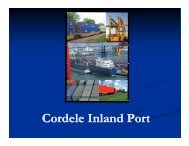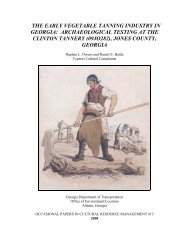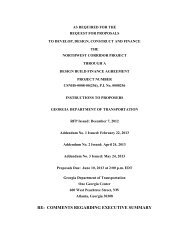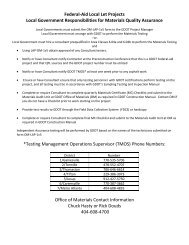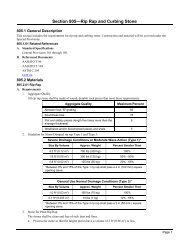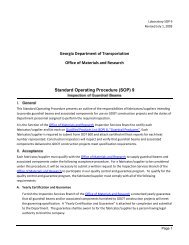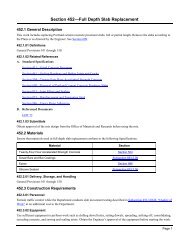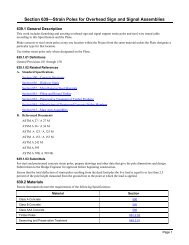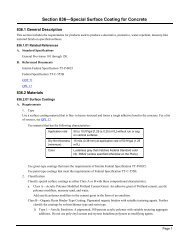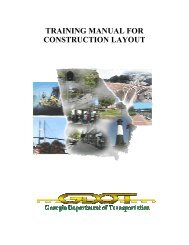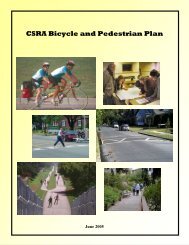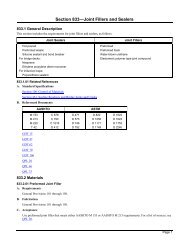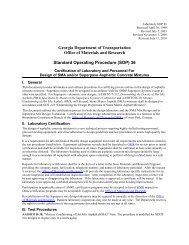Section 715 Bituminous Treated Roving
Section 715 Bituminous Treated Roving
Section 715 Bituminous Treated Roving
Create successful ePaper yourself
Turn your PDF publications into a flip-book with our unique Google optimized e-Paper software.
<strong>Section</strong> <strong>715</strong>—<strong>Bituminous</strong> <strong>Treated</strong> <strong>Roving</strong><br />
<strong>715</strong>.1 General Description<br />
This work includes furnishing and placing a layer of bituminous treated roving on planted slopes, ditches, waterways, and<br />
other areas according to the Plans or as directed by the Engineer.<br />
<strong>715</strong>.1.01 Definitions<br />
General Provisions 101 through 150.<br />
<strong>715</strong>.1.02 Related References<br />
A. Standard Specifications<br />
<strong>Section</strong> 822—Emulsified Asphalt<br />
B. Referenced Documents<br />
QPL 24<br />
<strong>715</strong>.1.03 Submittals<br />
Furnish the Department a certification from the manufacturer stating that glass fibers or fibrillated polypropylene yarn meets<br />
the requirements of this Specification.<br />
<strong>715</strong>.2 Materials<br />
Wind glass fibers or fibrillated polypropylene yarn into cylindrical packages so that the roving can be continuously fed<br />
through an ejector driven by compressed air and expanded into a mat.<br />
Lightly bind fibers or yarn together in a ribbon form without using clay, starch, or other damaging substances.<br />
For a list of sources, see QPL 24.<br />
Ensure that the material does not contain the following:<br />
More than 0.75 percent of saponificable acids<br />
Petroleum solvents<br />
Other agents known to be toxic to plant life<br />
A. Glass Fiber Material<br />
Ensure the glass fiber package weighs no less than 30 lbs (14 kg).<br />
B. Polypropylene Yarn Material<br />
Ensure the polypropylene yarn package meets these requirements:<br />
Weighs no less than 18 lbs (8 kg).<br />
The nominal size of the roving is 515 yd/lb (1038 m/kg).<br />
Contain enough UV inhibitors to retain 70 percent of its strength after 500 hours of exposure in an Atlas Twin Arc<br />
Weatherometer.<br />
C. <strong>Bituminous</strong> Material<br />
Use asphalt emulsion grade SS-1 or SS-1h according to <strong>Section</strong> 822 for tying down fiber or yarn material.<br />
<strong>715</strong>.2.01 Delivery, Storage, and Handling<br />
General Provisions 101 through 150.<br />
<strong>715</strong>.3 Construction Requirements<br />
<strong>715</strong>.3.01 Personnel<br />
General Provisions 101 through 150.<br />
Page 1
<strong>Section</strong> <strong>715</strong>—<strong>Bituminous</strong> <strong>Treated</strong> <strong>Roving</strong><br />
<strong>715</strong>.3.02 Equipment<br />
When applying glass fiber or polypropylene yarn, use an air compressor capable of supplying 40 ft³ (1.1 m³) of air per minute<br />
at 80 psi to 100 psi (550 kPa to 690 kPa) pressure. Run 3 kits simultaneously from a 125 ft³ (3.5 m³) compressor. Each kit<br />
will consist of:<br />
One air gun specifically designed for spraying glass fibers or polypropylene yarn<br />
Enough 3/8 in (10 mm) rubber hose for application<br />
At least one bucket container<br />
Do not use equipment that cuts or breaks the roving. Apply asphalt using equipment that sprays the material uniformly at the<br />
rates specified in Subsection <strong>715</strong>.3.05.<br />
<strong>715</strong>.3.03 Preparation<br />
General Provisions 101 through 150.<br />
<strong>715</strong>.3.04 Fabrication<br />
General Provisions 101 through 150.<br />
<strong>715</strong>.3.05 Construction<br />
A. <strong>Bituminous</strong> <strong>Treated</strong> Fibers<br />
Apply bituminous treated roving within 24 hours after planting an area with permanent grass. Apply roving and<br />
bituminous material uniformly over the planted areas at the following rates:<br />
1. On Slopes<br />
Spread glass fiber on slopes at the approximate rate of 0.2 to 0.25 lbs/yd² (110 g to 135 g/m²). Apply bituminous<br />
material at the approximate rate of 0.12 gal to 0.15 gal/yd² (0.5 L to 0.7 L/m²).<br />
2. In Waterways<br />
In waterways, ditches, flumes, and channels, spread glass fiber at the approximate rate of 0.4 lbs to 0.5 lbs/yd² (215<br />
g to 270 g/m²). Apply bituminous material at the approximate rate of 0.24 to 0.30 gal/yd² (1 L to 1.5 L/ m²).<br />
Areas covered with bituminous treated roving do not require an application of mulch.<br />
B. <strong>Bituminous</strong> <strong>Treated</strong> Polypropylene Yarn<br />
1. On Slopes<br />
Spread polypropylene yarn on slopes at the approximate rate of 0.10 lbs to 0.15 lbs/yd² (55 g to 80 g/m²). Apply<br />
bituminous material at the approximate rate of 0.12 gal to 0.15 gal/yd² (0.5 L to 0.7 L/m²).<br />
2. In Waterways<br />
In waterways, ditches, flumes and channels, spread polypropylene yarn at the approximate rate of 0.2 to 0.25 lbs/yd²<br />
(110 g to 135 g/m²). Apply bituminous material at the approximate rate of 0.24 to 0.30 gal/yd² (1 L to 1.5 L/m²).<br />
After the emulsified asphalt breaks and becomes tacky, lightly apply sand or pulverized soil to treated areas to<br />
prevent the treated area from sticking to anything that touches it. Do not apply sand or soil quantities that will<br />
damage newly planted areas if directed by the Engineer.<br />
C. Material Substitution<br />
When bituminous treated roving is specified, the Contractor has the option to substitute any of the following materials<br />
for bituminous treated roving:<br />
<strong>Section</strong> 710—Permanent Soil Reinforcing Mat<br />
<strong>Section</strong> 712—Fiberglass Blankets<br />
<strong>Section</strong> 713—Excelsior Blankets<br />
<strong>Section</strong> 714—Jute Mesh<br />
All of the materials, construction, and measurement portions of <strong>Section</strong> 710, <strong>Section</strong> 712, <strong>Section</strong> 713, or <strong>Section</strong> 714,<br />
whichever is selected, apply to this work.<br />
<strong>715</strong>.3.06 Quality Acceptance<br />
General Provisions 101 through 150.<br />
Page 2
<strong>Section</strong> <strong>715</strong>—<strong>Bituminous</strong> <strong>Treated</strong> <strong>Roving</strong><br />
<strong>715</strong>.3.07 Contractor Warranty and Maintenance<br />
Maintain treated areas to the Engineer’s satisfaction until Final Acceptance of the Project.<br />
<strong>715</strong>.4 Measurement<br />
The quantity of bituminous treated roving to be paid for is measured in the number of surface square yards (meters),<br />
complete and accepted. The quantity of materials substituted for bituminous treated roving as allowed by Subsection<br />
<strong>715</strong>.3.05.C will be measured according to the applicable portions of <strong>Section</strong> 710, <strong>Section</strong> 712, <strong>Section</strong> 713, or <strong>Section</strong> 714.<br />
<strong>715</strong>.4.01 Limits<br />
<strong>Treated</strong> slopes and waterways are measured separately.<br />
<strong>715</strong>.5 Payment<br />
This Work will be paid for at the Contract Price per square yard (meter) for bituminous treated roving of the type specified,<br />
complete in place and accepted. Materials substituted for bituminous treated roving will be paid for under Item No. <strong>715</strong>—<br />
<strong>Bituminous</strong> <strong>Treated</strong> <strong>Roving</strong> (waterways), per square yard (meter) complete, in place and accepted.<br />
Payment will be made under:<br />
Item No. <strong>715</strong> <strong>Bituminous</strong> treated roving (slopes) Per square yard (meter)<br />
Item No. <strong>715</strong> <strong>Bituminous</strong> treated roving (waterways) Per square yard (meter)<br />
<strong>715</strong>.5.01 Adjustments<br />
General Provisions 101 through 150.<br />
Page 3



